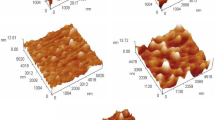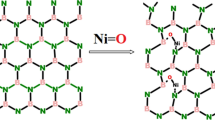Abstract
In this study, we report ZnO and Bismuth-doped ZnO (rBi/Zn) (r = 3, 6, 9 wt%) nanoparticles through the hydrothermal synthesis method. Different characterization techniques such as XRD, TGA, FTIR, XPS, FESEM, EDX analysis, UV spectroscopy, and PL spectroscopy have been used to investigate the influence of Bi+3 doping over the synthesized rBi/Zn nanoparticles. XRD result reveals a reduction of average particle size from 30 to 21 nm with the increment of Bi+3 (3 → 9 wt%) concentration. The mass variation in rBi/Zn was found more than the pure ZnO sample which reveals in TGA results. The material rBi/Zn exhibits a single-stage to multi-stage decomposition with the enhancement of Bi+3 (3 → 9 wt%) concentration while the XPS result indicates that the reduction of binding energy with increasing Bi+3 doping. UV analysis shows that as the concentration of Bi+3 increases the band gap of the material rBi/Zn reduces from 3.217 to 2.901 eV. However, the conductivity analysis shows the enhancement in the conductivity of rBi/Zn (0 → 6 wt%) but decreases from 6 → 9 wt%. Furthermore, the morphology of rBi/Zn also changes as the doping of Bi+3 increases which is possibly due to the enhancement of lattice mismatch, and pH variation. Such a kind of rBi/Zn nanocomposite material could be used in optoelectronic devices or fiber optics-based gas-sensing applications.















Similar content being viewed by others
References
Y. Zhang, M.K. Ram, E.K. Stefanakos, D. Yogi Goswam, J. Nanomater. 2012, 22 (2012)
K. Edalati, A. Shakiba, J. Vahdati-Khaki, S.M. Zebarjad, Mater. Res. Bull. 74, 374–379 (2016)
Da. Deng, S.T. Martin, S. Ramanathan, Nanoscale 2, 2685–2691 (2010)
H.-M. Kim, J.-H. Park, S.-K. Lee, Sci. Rep. 9, 15605 (2019)
X. Gao, X. Li, Yu. Weidong, J. Phys. Chem. B 109, 1155–1161 (2005)
C.J. Lan, H.Y. Cheng, R.J. Chung, J.H. Li, K.F. Kao, T.S. Chinz, J. Electrochem. Soc. 154, D117–D121 (2007)
L. Zhua, Y. Li, W. Zeng, Ceram. Int. 43, 14873–14879 (2017)
S. Narasimman, L. Balakrishnan, Z.C. Alex, RSC Adv. 8, 18243–18251 (2018)
B.K. Singh, S. Tripathi, J. Mater. Sci. 27, 2360–2366 (2016)
T. Fangsuwannarak, P. Krongarrom, J. Kaewphoka and S. T. Rattanachan, (10th international conference IEEE Computer, Telecommunications and Information Technology Krabi) 1–5 (2013).
S. Balachandran, M. Swaminathan, J. Phys. Chem. C 116, 26306–26312 (2012)
A. Boumezoued, K. Guergouri, R. Barille, D. Rechem, M. Zaabat, M. Rasheed, J. Alloys Compd. 791, 550–558 (2019)
D. Deng, Wu. Zhifu, G. Zhao, J. Zhao, Adv. Mater. Res. 740, 535–539 (2013)
J. Bo Zhong, J. Zhang Li, Y. Lu, X. Yang He, J. Zeng, W. Hu, Y. Cheng Shen, Appl. Surf. Sci. 258, 4929–4933 (2012)
P.M. Aneesh, K.A. Vanaja, M.K. Jayaraj, Proc. SPIE 6639, 66390J (2007)
B. Yuliarto, L. Nulhakim, M.F. Ramadhani, M. Iqbal, A. Nuruddin, IEEE Sens. J. 15, 4114–4120 (2015)
M. Li, F. Li, P.G. Yin, Chem. Phys. Lett. 601, 92–97 (2014)
S.S. Zahirullah, P. Immanuel, S. Pravinraj, P.F.H. Inbaraj, J.J. Prince, Mater. Lett. 230, 1–4 (2018)
M.J. Jabeen Fatima, A. Navaneeth, S. Sindhu, RSC Adv. 5, 2504–2510 (2015)
T.V.L. Thejaswini, D. Prabhakaran, M. Akhila Maheswari, J. Photochem. Photobiol. A 335, 217–229 (2017)
A.A. Ibrahim, G.N. Dar, S. Abbas Zaidi, A. Umar, M. Abaker, H. Bouzid, S. Baskoutas, Talanta 93, 257–263 (2012)
A. Hezam, K. Namratha, D. Ponnamma, Q.A. Drmosh, A.M. Nagi Saeed, C. Cheng, K. Byrappa, ACS Omega 3, 12260–12269 (2018)
H. Xie, F. Ding, Mu. Haichuan, Nanotechnology 30, 085708 (2019)
N.M. Shinde, Q. Xun Xia, J. Moon Yun, R.S. Mane, K. Ho Kim, ACS Appl. Mater. Interfaces 10, 11037–11047 (2018)
N. Sadananda Kumar, K.V. Bangera, C. Anandan, G.K. Shivakumar, J. Alloys Compd. 578, 613–619 (2013)
E.T. Seid, F.B. Dejene, J. Mater. Sci. 30, 11833 (2019)
T. Chitradevi, A. Jestin Lenus, N. Victor Jaya, Mater. Res. Express 7, 015011 (2019)
D. Ghosh, S. Balaji, K. Biswas, K. Annapurna, Mater. Sci. 50, 5450–5457 (2015)
Acknowledgements
The authors are gratefully acknowledged to the Director CSIR-CGCRI, the colleagues of the Fiber Optics & Photonics Division, and Material Characterization and Instrumentation Division for providing an experimental facility to carry out the research work.
Author information
Authors and Affiliations
Corresponding authors
Additional information
Publisher's Note
Springer Nature remains neutral with regard to jurisdictional claims in published maps and institutional affiliations.
Rights and permissions
About this article
Cite this article
Singh, S.K., Dhar, A. & Paul, M.C. Hydrothermal synthesis, characterization, and the influence of Bi+3 doping over nanocomposite thin films. J Mater Sci: Mater Electron 32, 5504–5519 (2021). https://doi.org/10.1007/s10854-021-05272-3
Received:
Accepted:
Published:
Issue Date:
DOI: https://doi.org/10.1007/s10854-021-05272-3




